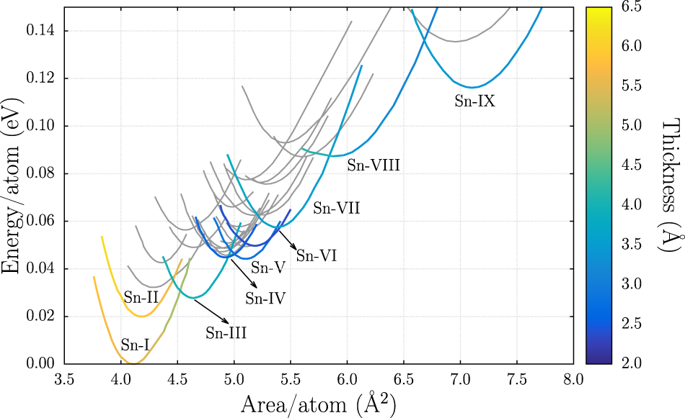npj 2D Materials and Applications ( IF 9.1 ) Pub Date : 2019-05-13 , DOI: 10.1038/s41699-019-0103-9 Pedro Borlido , Ahmad W. Huran , Miguel A. L. Marques , Silvana Botti

|
The family of group IV two-dimensional materials shows a rich variety of structural, electronic and topological properties. Only graphene is stable in the honeycomb structure, while buckling and dumbbell configurations stabilize silicene and germanene. Here we investigate from first principles the lowest-energy atomic arrangements of atomically-thin tin layers. Our calculations are performed with a very efficient method for global structural prediction, combined with constrains that enforce the desired one-dimensional confinement and include the effect of strain due to the substrate. We discover a series of new structures that span a large range of atomic densities and are considerably more stable than hexagonal single- or double-layer stanene, as well as dumbbell structures. The ground state, a metallic double layer with a square lattice that lies 295 meV/atom below honeycomb stanene and only 149 meV/atom above bulk α-tin, is akin to the atomic arrangement of a layer of romarchite tin oxide. Due to its enhanced stability with respect to honeycomb stanene, we propose that this structure can be easily synthesized on appropriate lattice-matched metallic substrates.
中文翻译:

稳定的原子薄锡层的结构预测
IV类二维材料族显示出丰富的结构,电子和拓扑特性。蜂窝结构中只有石墨烯稳定,而屈曲和哑铃状构型则稳定了硅烯和锗烯。在这里,我们从第一原理研究原子薄锡层的最低能量原子排列。我们的计算是通过一种非常有效的整体结构预测方法来进行的,并与强制实施所需的一维限制并包括由于基底引起的应变的影响的约束相结合。我们发现了一系列新的结构,这些结构跨越了大范围的原子密度,并且比六边形的单层或双层锡烷以及哑铃结构要稳定得多。基态α-锡类似于铬铁矿氧化锡层的原子排列。由于其相对于蜂窝锡具有增强的稳定性,因此我们建议可以在适当的晶格匹配的金属基材上轻松合成此结构。











































 京公网安备 11010802027423号
京公网安备 11010802027423号